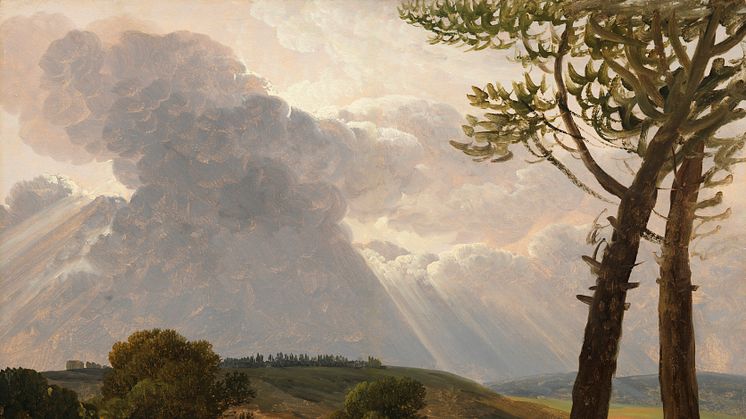
Press release -
New acquisition: Oil sketches by Pierre Henri de Valenciennes and Simon Denis
Nationalmuseum has acquired three landscape studies from Italy in oil by Pierre Henri de Valenciennes and Simon Denis. The works were hastily painted on paper on location, which was a novel approach in the late 18th century. This significant acquisition enables Nationalmuseum to better chart the beginnings of plein air painting in the 19th century.
Views of Rome and the surrounding countryside have a distinguished pedigree. For a long time, they remained true to the 17th-century landscape ideal and were painted in the studio. Valenciennes and Denis broke new ground by making sketches in oil, often on paper, on location. The light and weather conditions were as important as the subject, so the works were produced quickly. Despite being preparatory studies, these oil sketches laid the foundations for much of the 19th century’s plein air painting.
Pierre Henri de Valenciennes (1750–1819) is considered a pioneer who had a major influence on French art as both a theorist and a teacher. He was elected to the academy of fine arts in Paris in 1787, and served as professor of perspective theory from 1812 onward. Élémens de perspective pratique à l’usage des artistes (1800), his treatise on practical landscape painting with a focus on perspective, was particularly significant. Eventually his efforts led the academy to establish a dedicated prize for historical landscape painting.
The recently acquired view of Subiaco near Rome shows Valenciennes’ skill in capturing the lighting conditions and cloud shadows through brushwork that is both sensitive and vivid. The painting depicts the movement of the wind and its effects rather more than the landscape itself. Oil sketches of this kind, painted on location, differ radically from the works Valenciennes created in his studio. The latter portray an idealised version of nature, with scenes from classical mythology, but thanks to the introduction of oil sketches to the process, the lighting and colouring are markedly different from those seen in 17th-century landscape painting.
Simon Denis (1755–1813), a native of Antwerp, travelled via Paris to Italy, where he stayed for the rest of his life. Long overlooked, Denis was rediscovered in 1992 when a large number of his oil sketches were put up for sale. These had been passed down through generations of the artist’s descendants, so had stayed out of the public eye. His technique is reminiscent of Valenciennes, with similarly economical brushwork and a focus on the lighting and weather conditions. Unlike the idealised landscapes, the oil sketches portray nature as changeable, which the recently acquired pieces exemplify superbly. The view of the Roman Campagna in particular shows Denis’ skill in capturing atmospheric phenomena with great simplicity. The results are magnificent and the effect almost illusory.
The smaller oil sketch depicts Neptune’s Grotto at Tivoli. With masterful simplicity, Denis captures the play of light in the waterfall and the foliage in the foreground contrasted with the dark cliff. The work appears to have been painted in haste, with thinly applied colours that dried rapidly, allowing the artist to move on to the next layer. A crouching figure at lower right serves to illustrate the scale of the subject.
When Nationalmuseum reopens after renovations, these three new acquisitions will enable the museum to better chart the beginnings of plein air painting. This would not have been possible without the generous support of the Wiros Fund, the Sophia Giesecke Fund, and the Hedda and N D Qvist Memorial Fund. Nationalmuseum has no budget of its own for new acquisitions, but relies on gifting and financial support from private funds and foundations to enhance its collections of fine art and craft.
Press contacts
Carl-Johan Olsson, Curator, carl-johan.olsson@nationalmuseum.se, +46 8 519 543 24
Hanna Tottmar, Press Officer, press@nationalmuseum.se, +46 767 23 46 32
Categories
Nationalmuseum is Sweden’s premier museum of art and design. The collections comprise older paintings, sculpture, drawings and graphic art, and applied art and design up to the present day. The museum building is currently under renovation and scheduled to open again in 2018. In the meantime, the museum will continue its activities through collaborations both in Sweden and abroad as well as temporary exhibitions at Nationalmuseum Design at Kulturhuset Stadsteatern in Stockholm. Nationalmuseum has partnerships with Svenska Dagbladet and the Grand Hôtel Stockholm, and acknowledges the support of FCB Fältman & Malmén.

